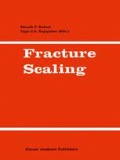Abstract
Two continuum mechanical models of interface fracture for interfaces joining materials where at least one undergoes plastic deformation are reviewed and examined critically. The embedded process zone model (EPZ model) has an adhesive zone, characterized by a work of separation and an interface strength, embedded within a continuum model of the adjoining materials. The SSV model imposes an elastic, plasticity-free layer of prescribed thickness between the interface and the surrounding elastic-plastic continuum. Crack advance requires the work of separation to be supplied by the local elastic crack tip field. The objective of each model is to provide the relation between the macroscopic interface toughness (the total work of fracture) and the work of separation. Under steady-state crack growth, the total work of fracture is the work of separation plus the work of plastic dissipation, the latter often far exceeding the former. It will be argued that each model has its own domain of validity, subject to the accuracy of conventional continuum plasticity at small scales, but neither is able to capture the dramatic trends which have been observed in macroscopic toughness measurements stemming from alterations in interface bonding conditions. A unified model is proposed which coincides with the two models in their respective domains of validity and provides a transition between them. Interface separation energy and interface strength (the peak separation stress) each play a central role in the unified model. Strain gradient plasticity is used to illustrate the effect of plastic deformation at the micron scale on the link between interface and macroscopic properties.
Access this chapter
Tax calculation will be finalised at checkout
Purchases are for personal use only
Preview
Unable to display preview. Download preview PDF.
References
Bagchi, A. and Evans, A.G. (1996). The mechanics and physics of thin film decohesion and its measurement. Interface Science 3, 169–193.
Begley, M.R. and Hutchinson, J.W. (1998). The mechanics of size dependent indentation. To be published in Journal of Mechanics and Physics of Solids.
Beltz, G.E., Rice, J.R. Shih, C.F. and Xia, L. (1996). A self-consistent model for cleavage in the presence of plastic flow. Acta Materialia 44, 3943–3954.
Evans, A.G., Hutchinson, J.W. and Wei, Y. (1998). Interface adhesion: effects of plasticity and segregation. Harvard University Report MECH 337 (to be published in Acta Materialia).
Fleck, N.A. and Hutchinson, J.W. (1997). Strain gradient plasticity. Advances in Applied Mechanics 33, 295–361.
Fleck, N.A., Muller, G.M., Ashby, M.F. and Hutchinson, J.W. (1994). Strain gradient plasticity: theory and experiment. Acta Metallurgica et Materialia 42, 475–487.
Lipkin, D.M., Clarke, D.R. and Beltz, G.E. (1996). A strain-gradient model of cleavage fracture in plastically deforming materials. Acta Materialia 44, 4051–4058.
Ma, Q. and Clarke, D.R. (1995). Size dependent hardness of silver single crystals. Journal of Materials Research 10, 853–863.
Needleman, A. (1987). A continuum model for void nucleation by inclusion debonding. Journal of Applied Mechanics 54, 525–531.
Nix, W.D. and Gao, H. (1998). Indentation size effects in crystalline materials: A law for strain gradient plasticity. Journal of Mechanics and Physics of Solids 46, 411–425.
Poole, W.J., Ashby, M.F. and Fleck, N.A. (1996). Micro-hardness of annealed and work-hardened copper polycrystals. Scripta Metallurgica et Materialia 34, 559–564.
Raynolds, J.E., Smith, J.E. Zhao, G.L. and Srolovitz, D.J. (1996). Physical Reviews B 53, 13883–13890.
Rice, J.R. (1988). Elastic fracture concepts for interfacial cracks. Journal of Applied Mechanics 55, 98–103.
Rice, J.R. and Thomson, R. (1974). Ductile vs. brittle behavior of crystals. Philosophical Magazine 29, 73–97.
Rice, J.R., Suo, Z. and Wang, J.S. (1990). Mechanics and thermodynamics of brittle interfacial failure in bimaterial systems. In Metal-Ceramic Interfaces, (Edited by M. Ruhle, A.G. Evans, M.F. Ashby and J.P. Hirth), Pergamon Press, New York, 269–294.
Rousselier, G., Devaux, J.-C., Mottet, G. and Devesa, G. (1989). A methodology for ductile fractureanalysis based on damage mechanics: an illustration of a local approach of fracture. in Nonlinear Fracture Mechanics: Vol. 11, Elastic-Plastic Fracture, ASTM STP 995 (Edited by J.D. Landes, A. Saxena and J.G. Merkle) American Society of Testing Materials, Philadelphia, 332–354.
Stelmashenko, N.A., Walls, M.G., Brown, L.M. and Milman, Y.V. (1993). Microindentations on W and Mo oriented single crystals: An STM study. Acta Metallurgica et Materialia 41, 2855–2865.
Suo, Z., Shih, C.F. and Varias, A.G. (1993). A theory for cleavage cracking in the presence of plastic flow. Acta Metallurgica et Materialia 41, 1551–1557.
Tvergaard, V. (1997). Cleavage crack growth resistance due to plastic flow around a near-tip dislocation-free region. Journal of Mechanics and Physics of Solids 45, 1007–1023.
Tvergaard, V. and Hutchinson, J.W. (1992). The relation between crack growth resistance and fracture process parameters in elastic-plastic solids. Journal of Mechanics and Physics of Solids 40, 1377–1397.
Tvergaard, V. and Hutchinson, J.W. (1993). The influence of plasticity on mixed mode interface toughness. Journal of Mechanics and Physics of Solids 41, 1119–1135.
Wei, Y. and Hutchinson, J.W. (1997). Steady-state crack growth and work of fracture for solids characterized by strain gradient plasticity, Journal of Mechanics and Physics of Solids 45, 1253–1273.
Xia, L. and Shih, C.F. (1995). Ductile crack growth — I. A numerical study using computational cells with microstructurally-based length scales. Journal of Mechanics and Physics of Solids 43, 223–259.
Author information
Authors and Affiliations
Editor information
Editors and Affiliations
Rights and permissions
Copyright information
© 1999 Springer Science+Business Media Dordrecht
About this chapter
Cite this chapter
Wei, Y., Hutchinson, J.W. (1999). Models of interface separation accompanied by plastic dissipation at multiple scales. In: Bažant, Z.P., Rajapakse, Y.D.S. (eds) Fracture Scaling. Springer, Dordrecht. https://doi.org/10.1007/978-94-011-4659-3_1
Download citation
DOI: https://doi.org/10.1007/978-94-011-4659-3_1
Publisher Name: Springer, Dordrecht
Print ISBN: 978-94-010-5965-7
Online ISBN: 978-94-011-4659-3
eBook Packages: Springer Book Archive

